Design and Safety Assessment of Recommended Route off the Western Coast of Izu O Shima Island
Abstract
1. Introduction
2. Overview of the RR
2.1. The Target Area
2.2. Description of IMO Regulations
2.2.1. Approaches for Separating Traffic Flows
2.2.2. Design Method of RRs
3. Method of Design and Safety Assessment
3.1. Overview of the Safety Assessment Method
- Preliminary analysis of the navigational environment
- Detailed analysis of the navigational environment
- Design of new RR candidates
- Quantitative assessment based on the present and predicted future traffic flows
- Determination of the optimal ship routeing
3.2. Safety Assessment Method
3.2.1. Concept
3.2.2. Encounter Frequency
3.2.3. Obstacle Zone by Target (OZT)
- Draw a circle of radius DS centered on the own ship (point O).
- Draw tangent lines from the target ship (point T) to this circle. Let the contact points be T1 and T2.
- Draw the negative motion vector of ship T (−VT) behind ship T. Let the endpoint of the vector be C.
- Draw a circle of radius of the own ship speed (|VO|) centered on point C.
- Let the intersections of the tangent lines and the circle of radius of VO be D1 and D2.
- Shift the and to point O.
- Cut out a part of the course line from the target ship by these collision courses.
- Define EZ as a wedge-shaped area with threshold values of the angles and distance from the own ship.
- The OZT that was at least partially within the EZ is considered a dangerous OZT.
- The number of dangerous OZTs was accumulated for each small grid.
4. Design and Safety Assessment of the RR
4.1. Preliminary Analysis of the Navigational Environment
4.1.1. Collisions
4.1.2. Traffic Density
4.1.3. Activities of Fishing Boats
4.2. Detailed Analysis of the Navigational Environment
4.2.1. OD Survey
4.2.2. Encounter Frequency Distribution
4.2.3. Generation of Traffic Flow Model
- (1)
- Simulation time window of the day
- (2)
- Ship classification for ship generation
- Category ID 0 is small tanker, cargo, and others equipped with AIS, whose speed are approximately low;
- Category ID 1 is for medium-sized tanker, cargo, and others equipped with AIS, whose speed is approximately medium;
- Category ID 2 is large tanker, cargo, and others equipped with AIS, whose speed are approximately high;
- Category ID 3 is passenger ships equipped with AIS that travel on a regular schedule;
- Category ID 4 is small tanker, cargo, and others without AIS;
- Category ID 5 is fishing boats.
- (3)
- Number of sailing ships
- (4)
- Passage position
4.3. Design of New RR Candidates
- The direction of the center line should divide the area with high encounter frequency into two parts;
- Positions of major fishing grounds should be in a one-way traffic flow of sailing ships so that fishing boats can carefully concentrate in one direction where the ships come from;
- Ships navigating along the RR should not be significantly diverted compared to the present situation;
- In the case when ship traffic has waypoints in the target area, the center line should be set away from such waypoints to avoid disrupting the ships;
- The direction of the center line should be close to the course angle of the current traffic flow.
4.4. Quantitative Assessment Based on the Present and Predicted Future Traffic Flows
4.4.1. Prediction of Future Traffic
- Eastbound ships passing Mikomotoshima North first sail toward the southern end of the center line and then follow the course toward the next way point;
- Eastbound ships passing Mikomotoshima South change their courses off at the southern tip of Izu peninsula and sail along the extension of the center line;
- Westbound ships passing Mikomotoshima North change their courses at the north of Izu O Shima Island and sail toward the northern waterway of Mikomotoshima;
- Westbound ships passing Mikomotoshima South first pass through the north of Izu O Shima Island and then take a course parallel to the center line;
- Most of the ships comply with the RR. However, there are partial number of ships that are unaware of its existence for some reason.
4.4.2. Safety Assessment of the RR
- (1)
- Encounter frequency
- remarkably smaller size of the high encounter frequency area;
- remarkably lower encounter frequency around the fishing ground;
- slightly higher encounter frequency at the northern end of the center line.
- (2)
- OZT
- high-frequency areas at the intersections of the trajectories similar to the present traffic, which are indicated in areas A and B;
- narrower high-frequency areas under each plan, which are indicated in area C and E;
- new middle–high-frequency areas in the southern area under each plan, which are indicated in area C;
- a slightly smaller high-frequency area in the fishing ground under each plan, which is indicated in area D.
4.5. Selection of the Optimal Ship Routeing
- the major routes of merchant ships would be separated by direction of travel, reducing head-on collisions;
- the traffic environment of fishing boats would be simplified, reducing the watch-keeping load and thus collisions against merchant ships.
5. Discussion
5.1. Effectiveness in Encounter Frequency Perspective
5.2. Effectiveness in OZT Perspective
5.3. Effectiveness in the Number of Collisions
6. Conclusions
Author Contributions
Funding
Institutional Review Board Statement
Informed Consent Statement
Data Availability Statement
Acknowledgments
Conflicts of Interest
References
- Marzoug, R.; Ez-Zahraouy, H.; Benyoussef, A. Simulation study of car accidents at the intersection of two roads in the mixed traffic flow. Int. J. Mod. Phys. C 2015, 26, 1550007. [Google Scholar] [CrossRef]
- Fujii, Y. Chapter 4 Maritime Traffic Accidents. In Introduction of Marine Traffic Engineering, 1st ed.; Kaibundo: Tokyo, Japan, 1971. (In Japanese) [Google Scholar]
- Itoh, H. Method for prediction of ship traffic behaviour and encounter frequency. J. Navig. 2022, 75, 106–123. [Google Scholar] [CrossRef]
- JCG. Current Status of Marine Accidents and Countermeasures. Available online: https://www6.kaiho.mlit.go.jp/info/keihatsu/20180314_state_measure29.pdf (accessed on 20 June 2022). (In Japanese).
- Ministry of Land, Infrastructure, Transport and Tourism. Summary of the White Paper on Land, Infrastructure, Transport and Tourism in Japan 2021. Available online: https://www.mlit.go.jp/statistics/content/001442571.pdf (accessed on 20 June 2022).
- Miyake, R.; Itoh, H.; Nishizaki, C.; Fukuto, J. Method of safety assessment for establishing ship routeing system with marine traffic simulation. In Proceedings of the 7th International Conference on Collision and Grounding of Ships and Offshore Structures (ICCGS), Ulsan, Korea, 15–18 June 2016. [Google Scholar]
- Miyake, R.; Itoh, H.; Nishizaki, C.; Fukuto, J. Safety assessment for establishing ships’ routeing—Recommended route off the western coast of Izu O Shima island. In Proceedings of the 4th Asian Conference on Defense Technology (ACDT), Tokyo, Japan, 29 November–1 December 2017. [Google Scholar]
- Japan Association of Marine Safety. The Investigation on Development of Safety Measures off the Western Coast of Izu O Shima Island; The Japan Association of Marine Safety: Tokyo, Japan, 2016. (In Japanese) [Google Scholar]
- NCSR4/3; Routeing Measures and Mandatory Ship Reporting Systems—Establishment of a Recommended Route off the Western Coast of Izu o Shima Island, Japan. The Sub-Committee on Navigation, Communications and Search and Rescue (NCSR): London, UK, 2016.
- SN.1/Circ.335; Routeing Measures Other than Traffic Separation Schemes. IMO: London, UK, 2017.
- Japan Transport Safety Board. Investigation Report. Available online: https://www.mlit.go.jp/jtsb/eng-mar_report/2015/2013tk0026e.pdf (accessed on 20 June 2022).
- Itoh, H.; Miyake, R. Research on Change of Traffic Safety Accompanying the Implementation of a New Recommended Route. In Proceedings of the 8th International Conference on Collision and Grounding of Ships and Offshore Structures (ICCGS), Lisbon, Portugal, 21–23 October 2019. [Google Scholar]
- IMO. Part A—General provisions on ships’ routeing. In SHIPS’ Routeing 2008 Edition, 9th ed.; IMO: London, UK, 2008; ISBN 978-92-801-4232-7. [Google Scholar]
- MSC/Circ.1060; Guidance Note on the Preparation of Proposals on Ships’ Routeing Systems and Ship Reporting Systems for Submission to the Sub-Committee on Safety of Navigation. The Maritime Safety Committee (MSC): London, UK, 2003.
- Miyake, R.; Itoh, H.; Nishizaki, C.; Fukuto, J. Establishment of an Assessment Method for New Ship s’ Routeing System with a Marine Traffic Simulation System. Pap. Natl. Marit. Res. Inst. NMRI 2017, 16, 267–282. (In Japanese) [Google Scholar]
- Kang, W.; Park, Y. A Study on the Design of Coastal Fairway Width Based on a Risk Assessment Model in Korean Waterways. Appl. Sci. 2022, 12, 1535. [Google Scholar] [CrossRef]
- Pietrzykowski, Z.; Uriasz, J. The ship domain—A criterion of navigational safety assessment in an open sea area. J. Navig. 2009, 62, 93–108. [Google Scholar] [CrossRef]
- Liu, J.; Zhou, F.; Li, Z.; Wang, M.; Liu, R.W. Dynamic Ship Domain Models for Capacity Analysis of Restricted Water Channels. J. Navig. 2015, 69, 481–503. [Google Scholar] [CrossRef]
- Fujii, Y.; Makishima, T.; Hara, K. Chapter 2 Traffic Investigation. In Marine Traffic Engineering, 1st ed.; Kaibundo: Tokyo, Japan, 1981; ISBN 978-4-303–23401-0. (In Japanese) [Google Scholar]
- Japan Association of Marine Safety. The Investigation on Development of Safety Measures for Accident-Prone Locations; The Japan Association of Marine Safety: Tokyo, Japan, 2012. (In Japanese) [Google Scholar]
- Macduff, T. The probability of vessel collisions. Ocean. Ind. 1974, 9, 144–148. [Google Scholar]
- Fujii, Y. Integrated study on marine traffic accidents. In Proceedings of the IABSE Colloquium on Ship Collision with Bridges and Offshore Structures, Copenhagen, Denmark, 30 May–2 June 1983; Volume 42, pp. 91–98. [Google Scholar] [CrossRef]
- Pedersen, P.T. Collision and Grounding Mechanics. In Proceedings of the WEMT Conference 1995, Kopenhagen, Denmark, 17–19 May 1995; pp. 125–157. [Google Scholar]
- Kawashima, S.; Itoh, H.; Kimura, A. Collision frequency to offshore floating installation based on analysis of ship traffic flow. J. Japan Inst. Navig. 2017, 136, 80–87. (In Japanese) [Google Scholar]
- Kawashima, S.; Itoh, H. Assessment of ship encounter and collision in congested sea areas. In Proceedings of the 8th International Conference on Collision and Grounding of Ships and Offshore Structures (ICCGS), Lisbon, Portugal, 21–23 October 2019. [Google Scholar]
- Imazu, H.; Fukuto, J.; Numano, M. Obstacle Zone by Target and its Expression. J. Jpn. Inst. Navig. 2002, 107, 191–197. [Google Scholar] [CrossRef]
- Imazu, H.; Fujisaka, T.; Shouji, R.; Ootake, Y. The Crossing Maneuver Characteristic Seen from Obstacle Zone by Target. J. Jpn. Inst. Navig. 2003, 108, 259–265. [Google Scholar] [CrossRef]
- Imazu, H. Computation of OZT by using Collision Course. Navig. Jpn. Inst. Navig. 2014, 188, 78–81. [Google Scholar]
- Imazu, H. Evaluation Method of Collision Risk by Using True Motion. TransNav Int. J. Mar. Navig. Saf. Sea Transp. 2017, 11, 65–70. [Google Scholar] [CrossRef][Green Version]
- Sawada, R.; Sato, K.; Majima, T. Automatic ship collision avoidance using deep reinforcement learning with LSTM in continuous action spaces. J. Mar. Sci. Technol. 2021, 26, 509–524. [Google Scholar] [CrossRef]
- Japan Association of Marine Safety. The Investigation on Unification of Control Center in Tokyo Bay; The Japan Association of Marine Safety: Tokyo, Japan, 2015. (In Japanese) [Google Scholar]
- Toyo-Shingo-Tsushinsha, AIS Data Feed. Available online: https://www.toyoshingo.co.jp/en/service/information/ais_data.html (accessed on 1 August 2022).
- Japan Shipping Exchange, Inc. Japanese Register of Ships; Japan Shipping Exchange, Inc.: Tokyo, Japan, 2014. (In Japanese) [Google Scholar]
- Japan Transport Safety Board. Japan-Marine Accident Risk and Safety Information System (J-MARISIS). Available online: https://jtsb.mlit.go.jp/hazardmap/index_en.html (accessed on 20 June 2022).

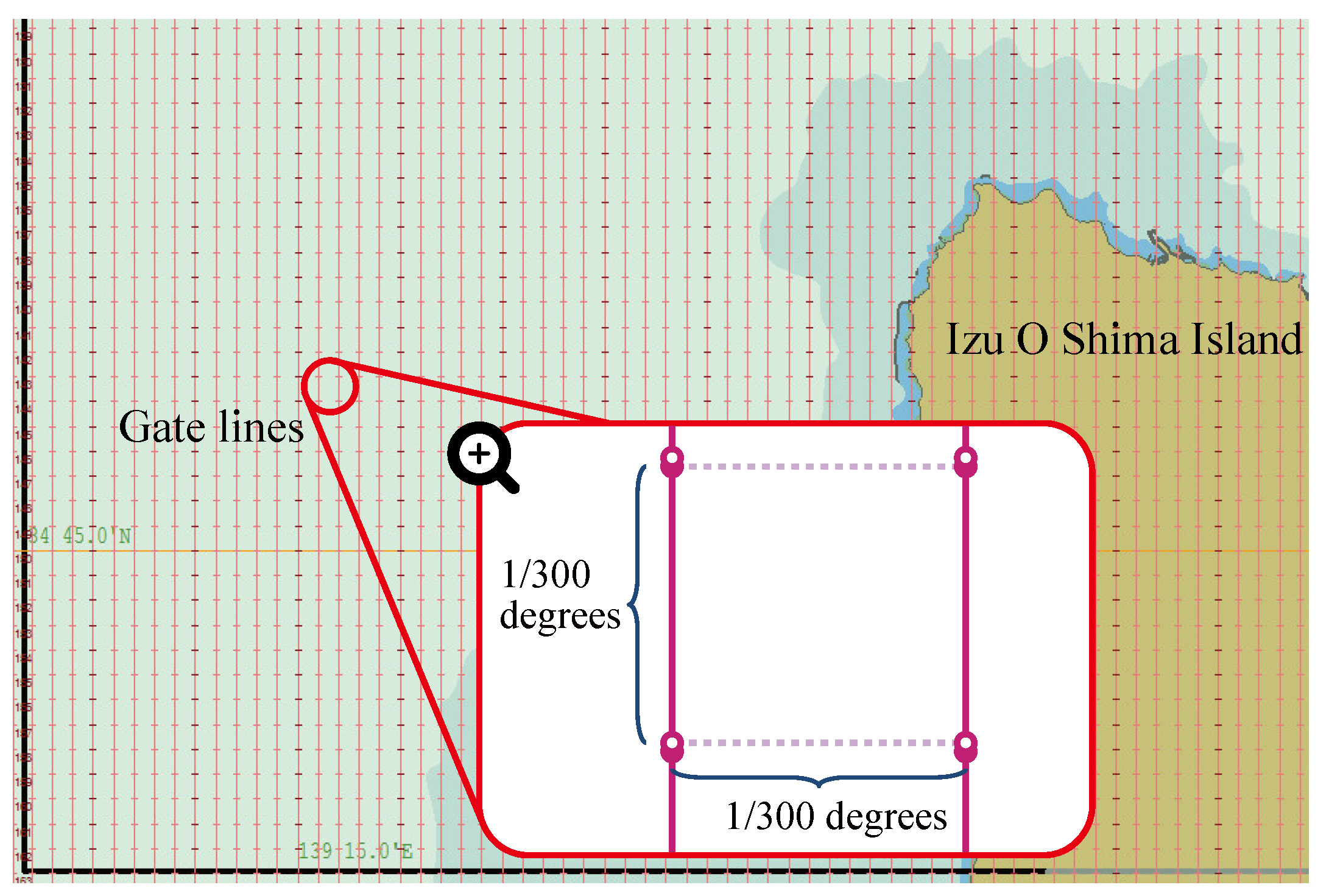

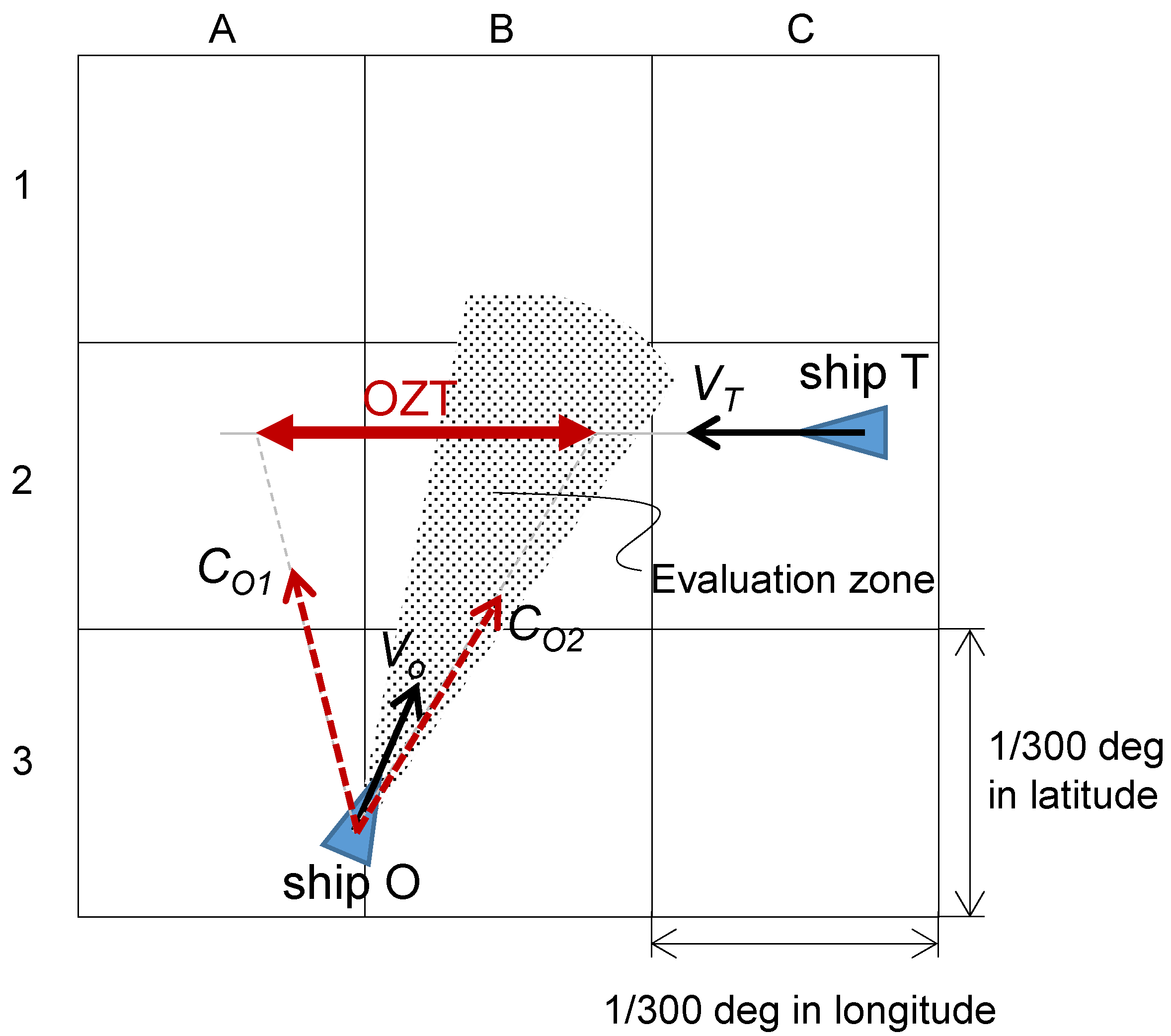
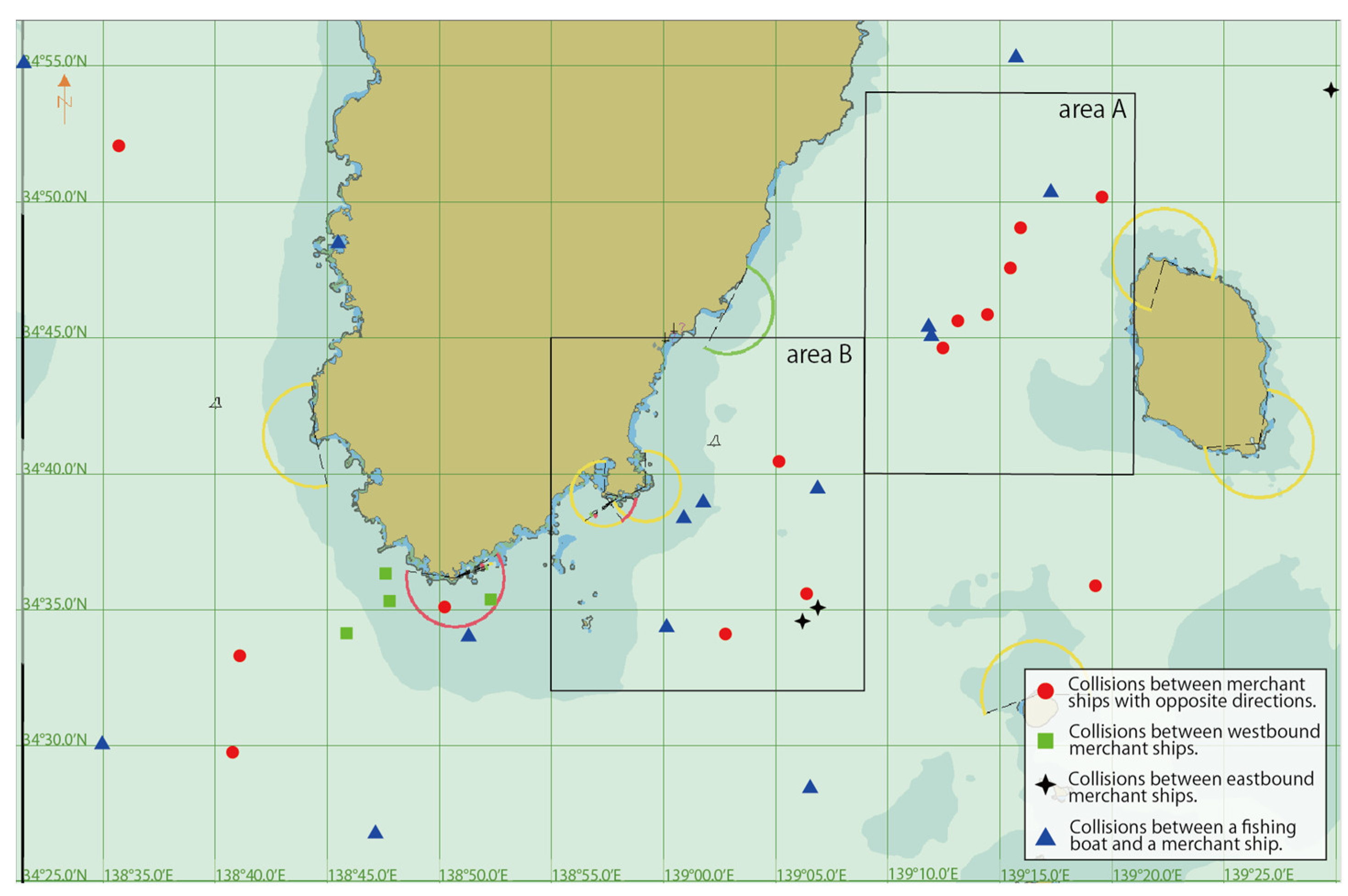
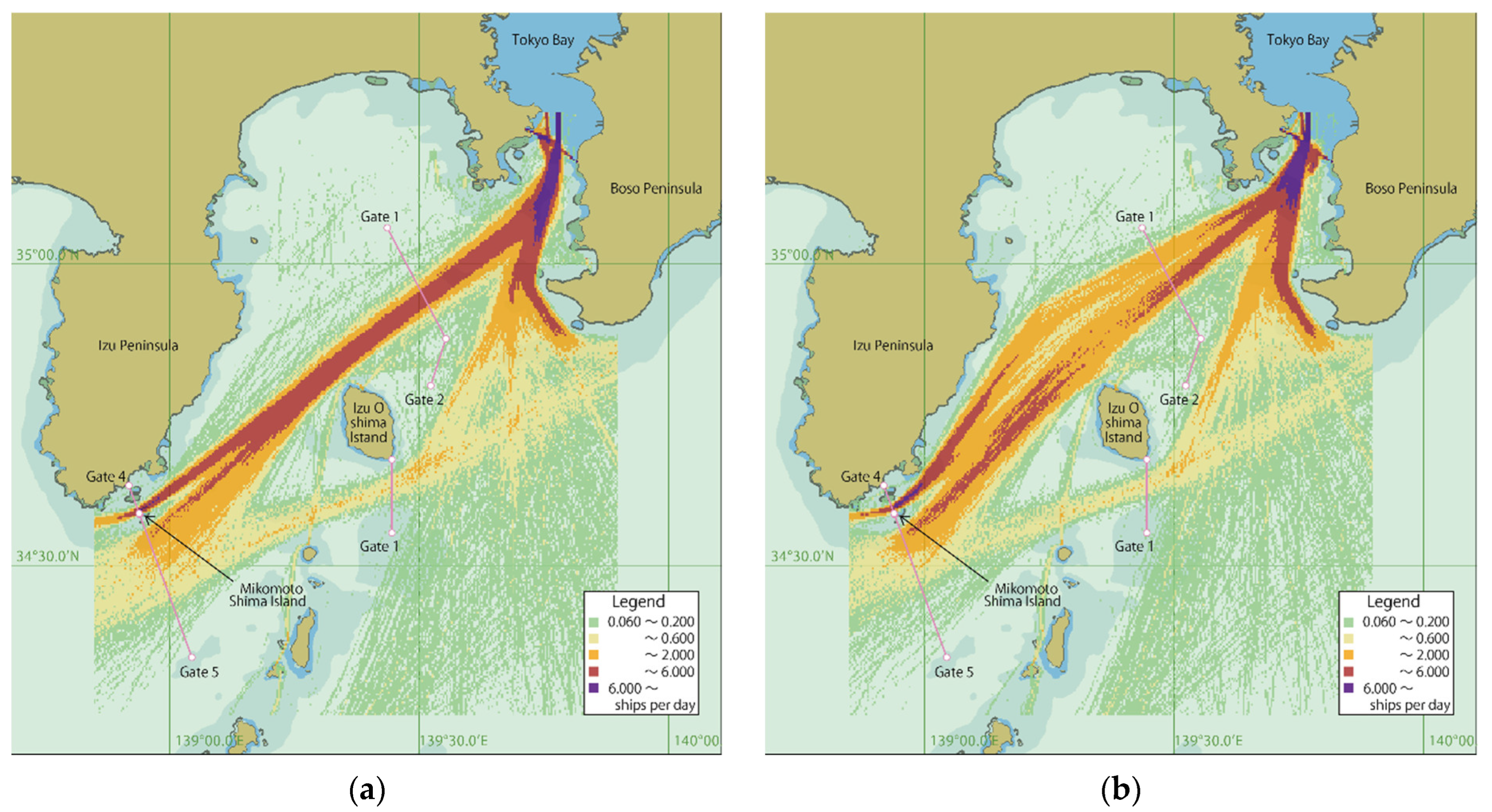

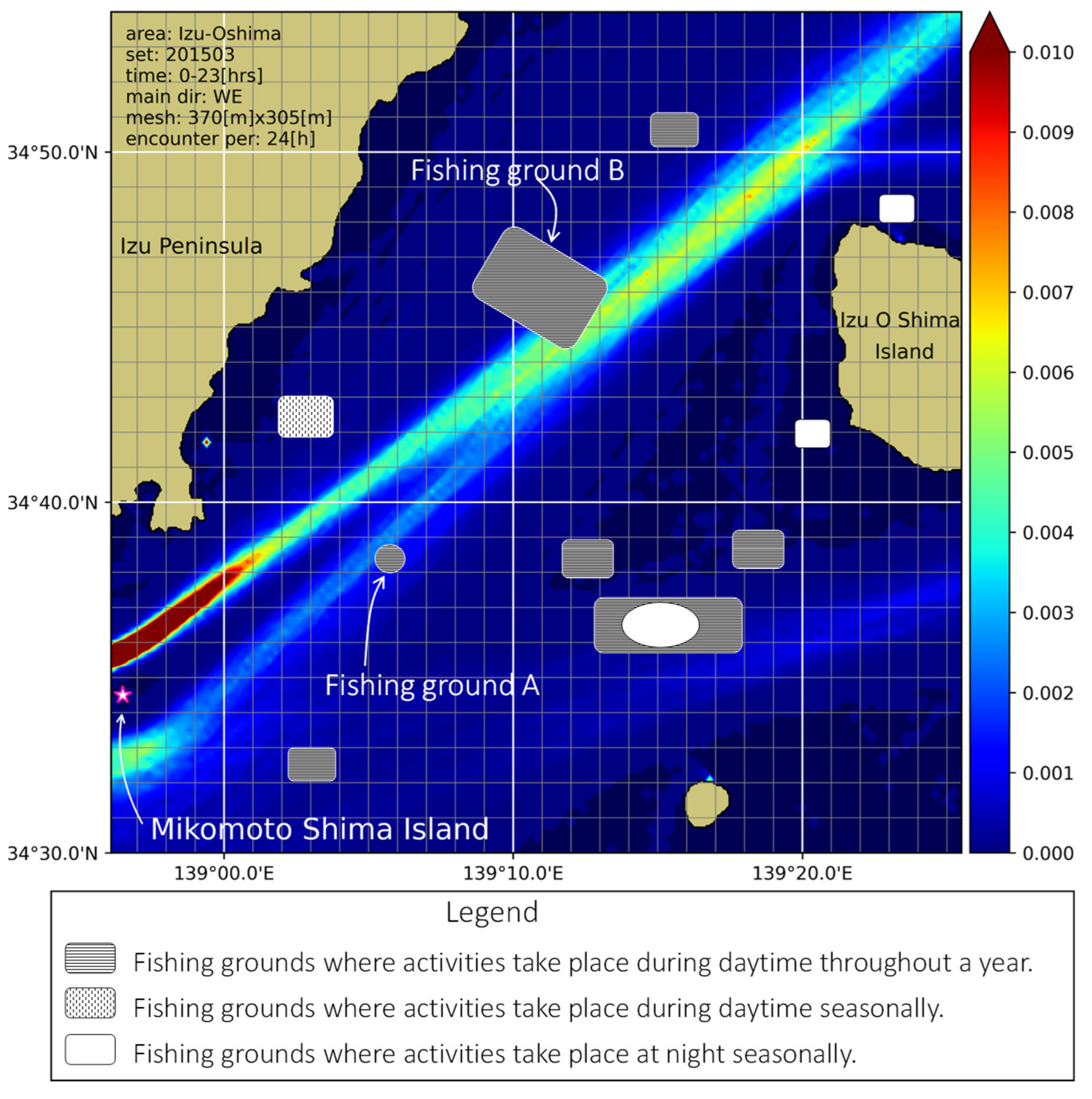
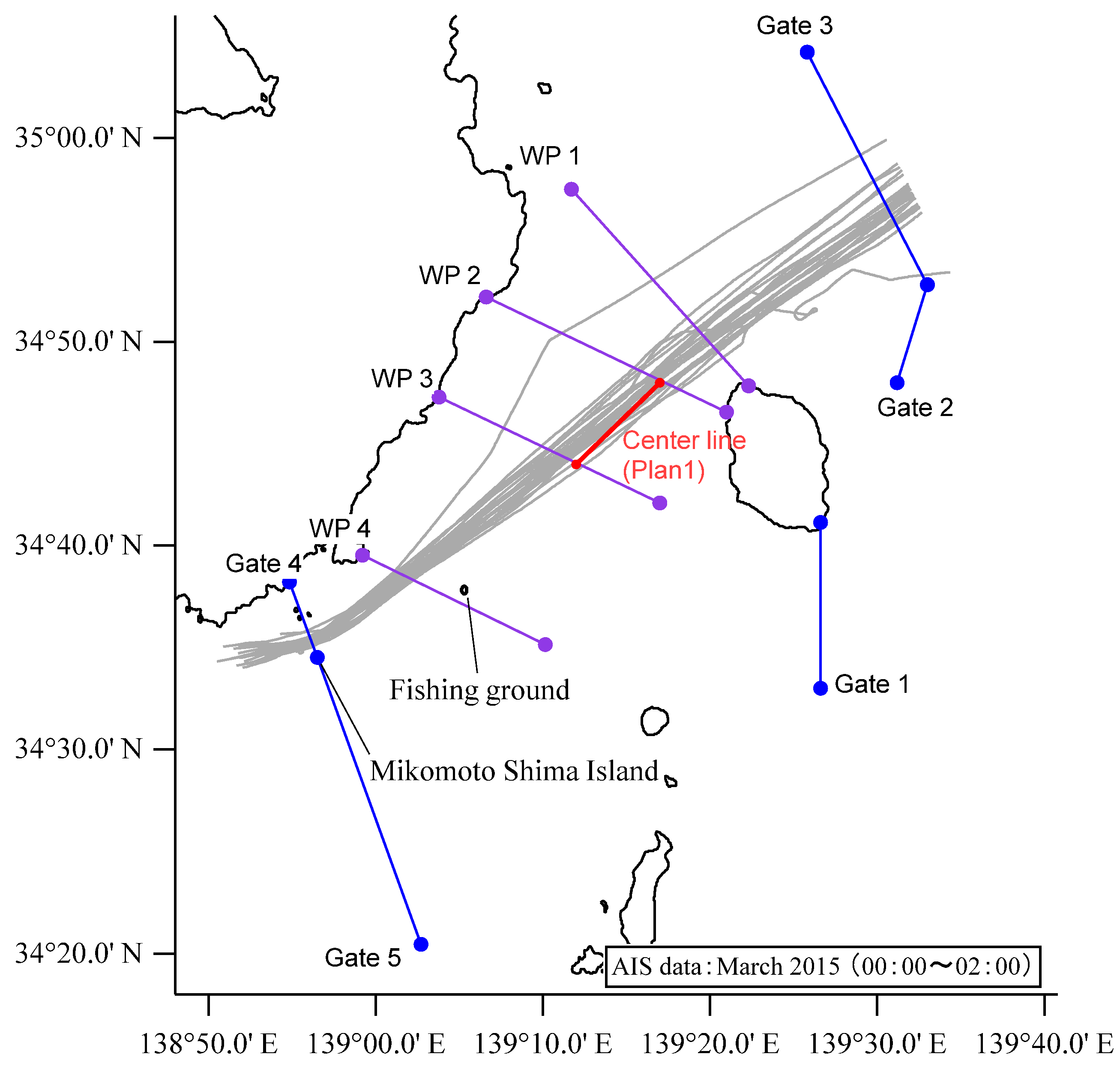
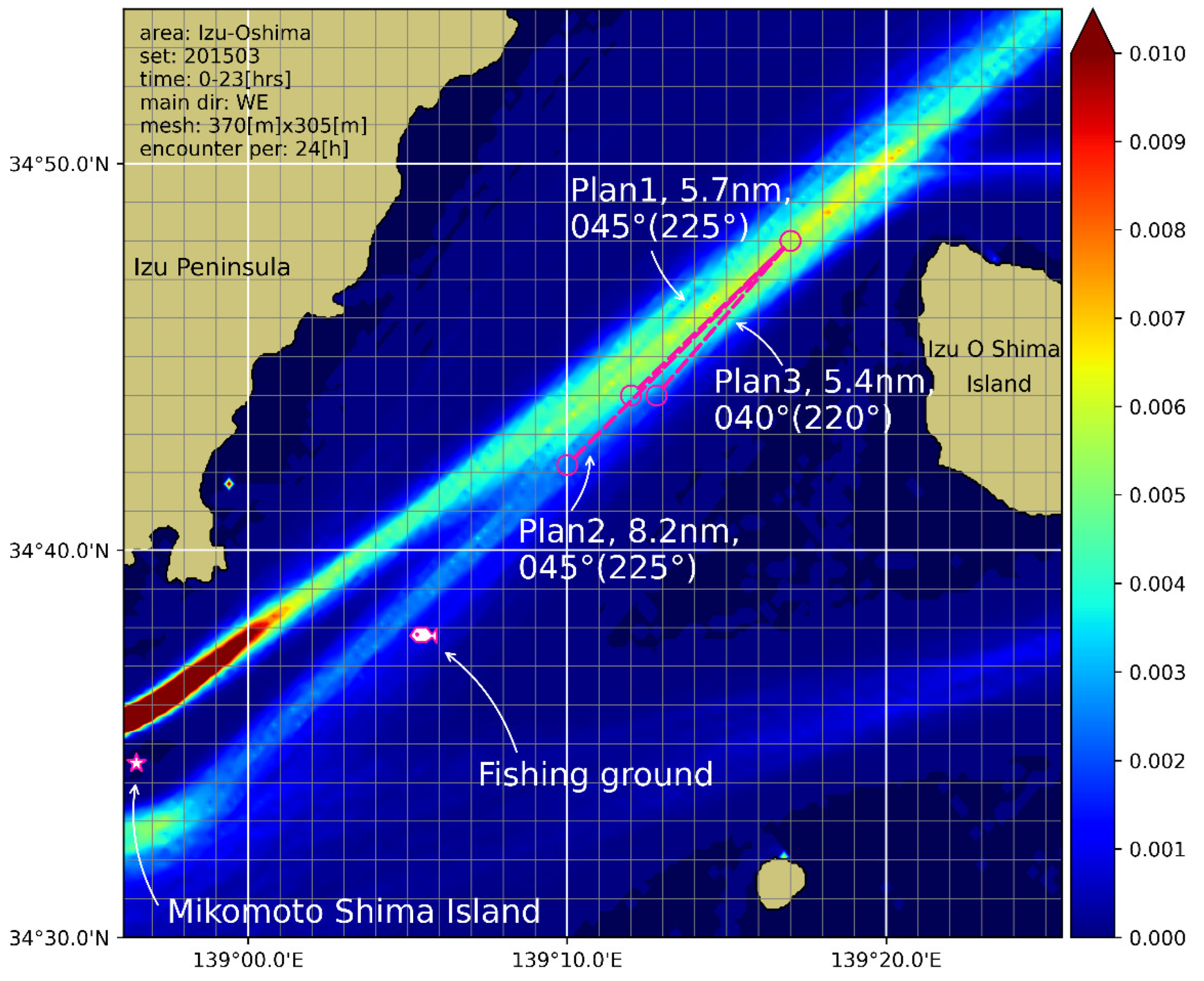
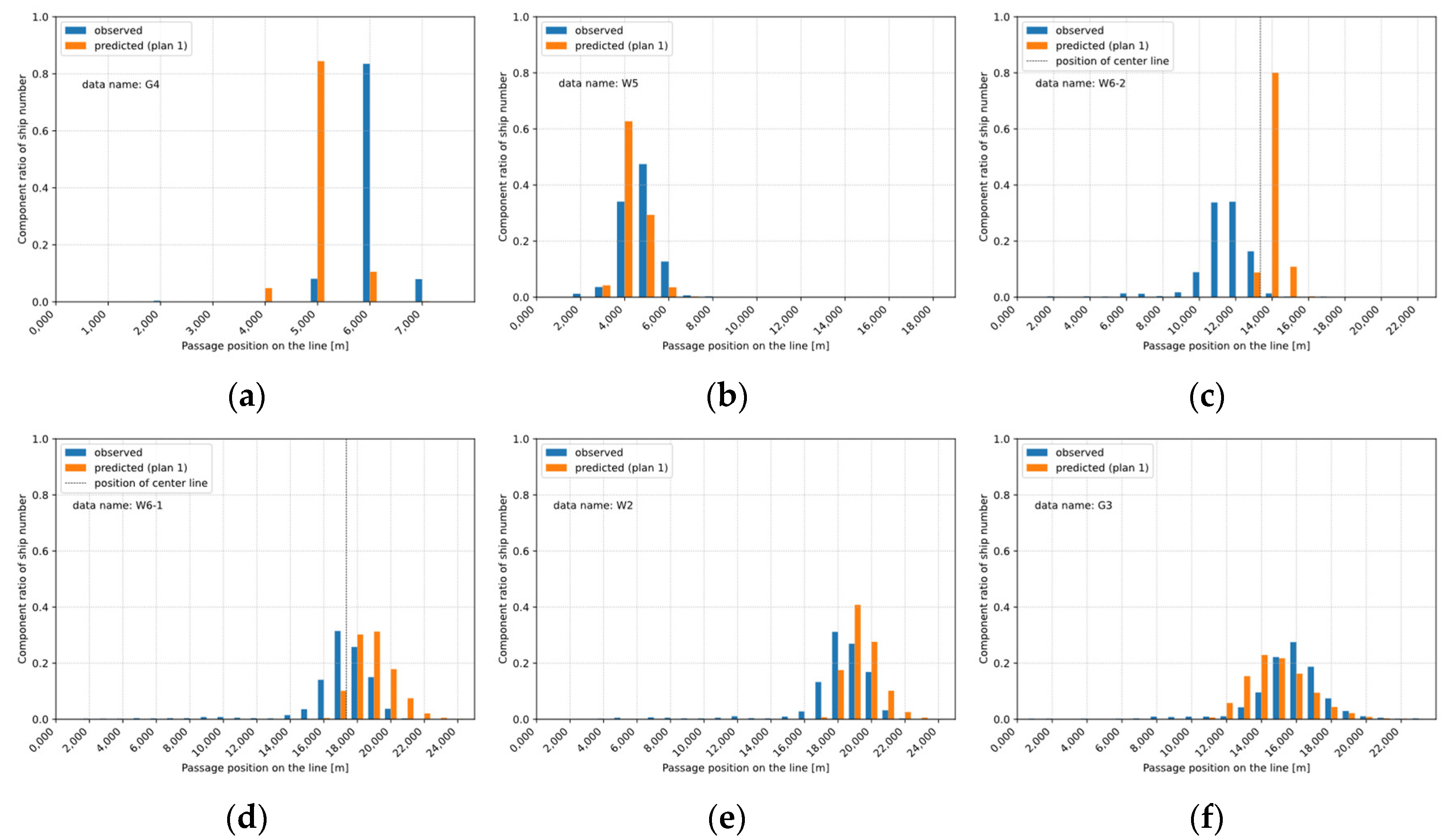

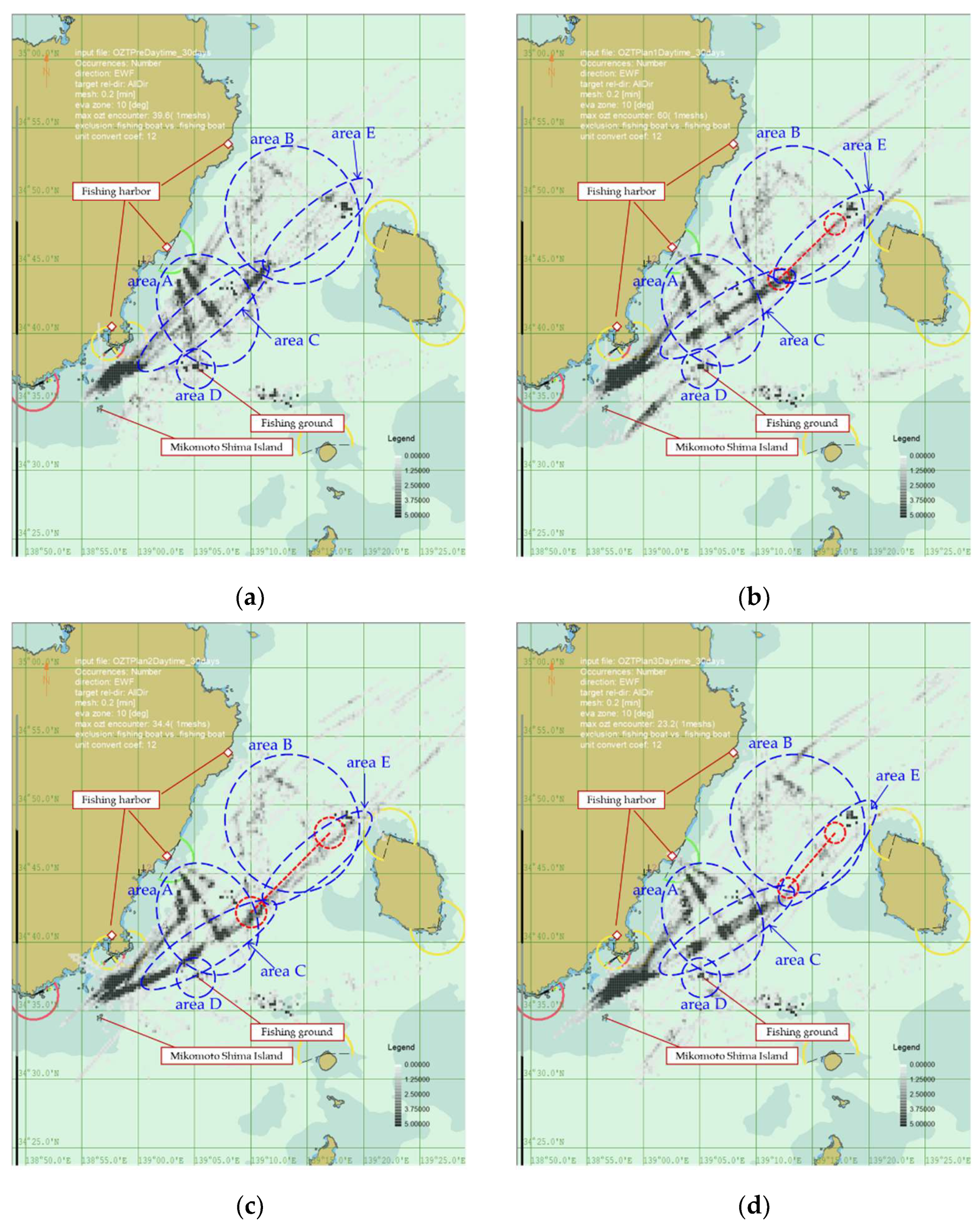
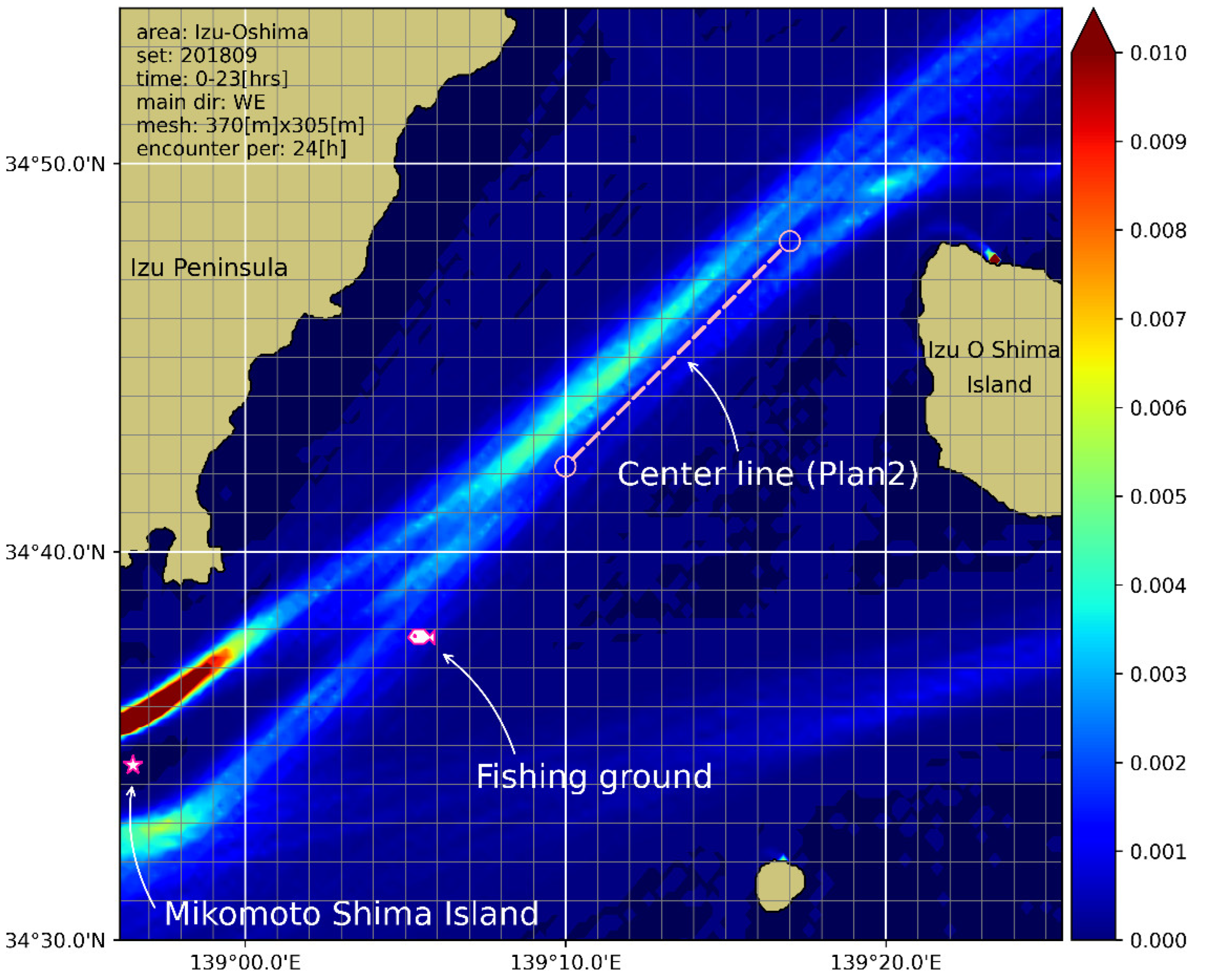
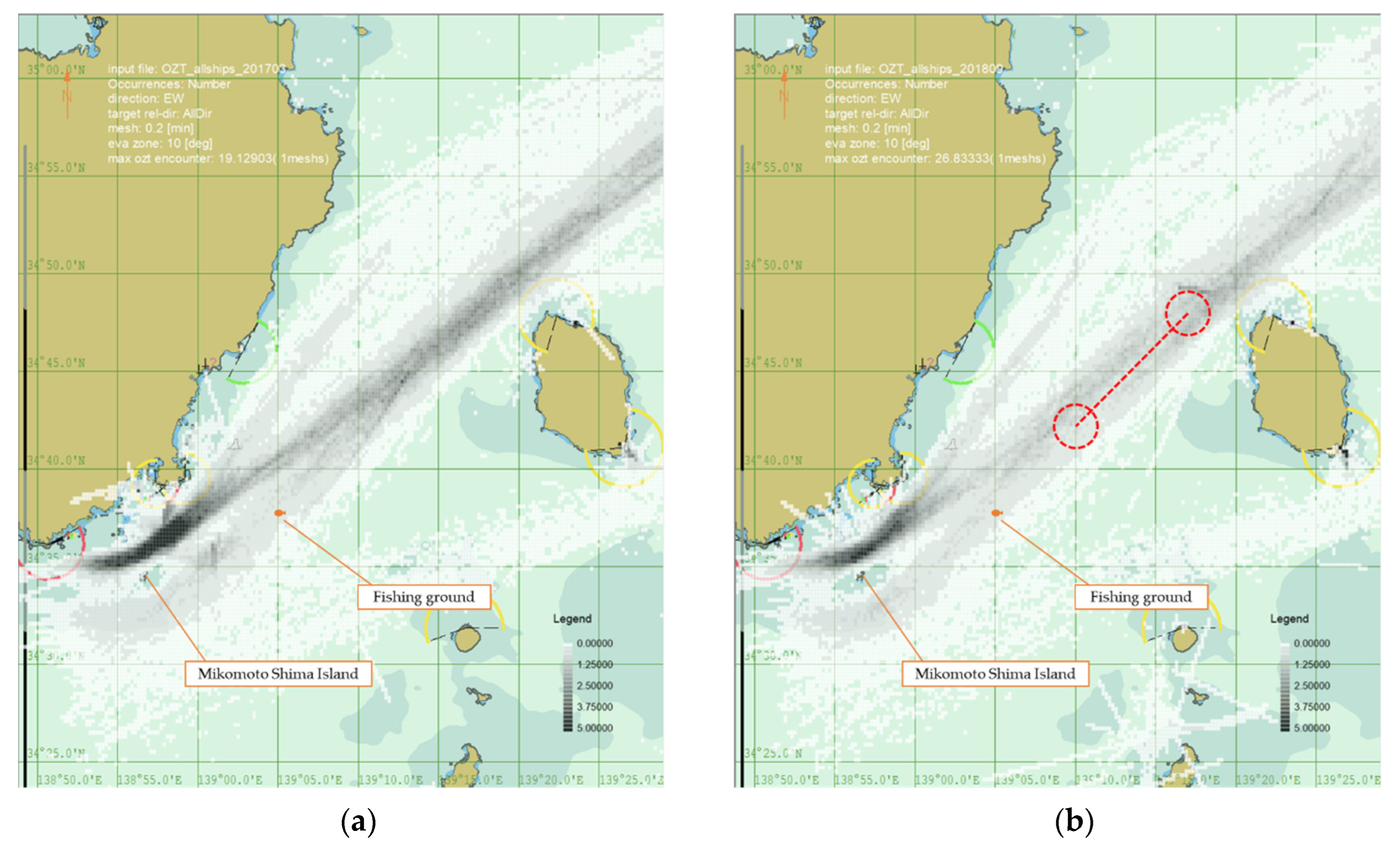
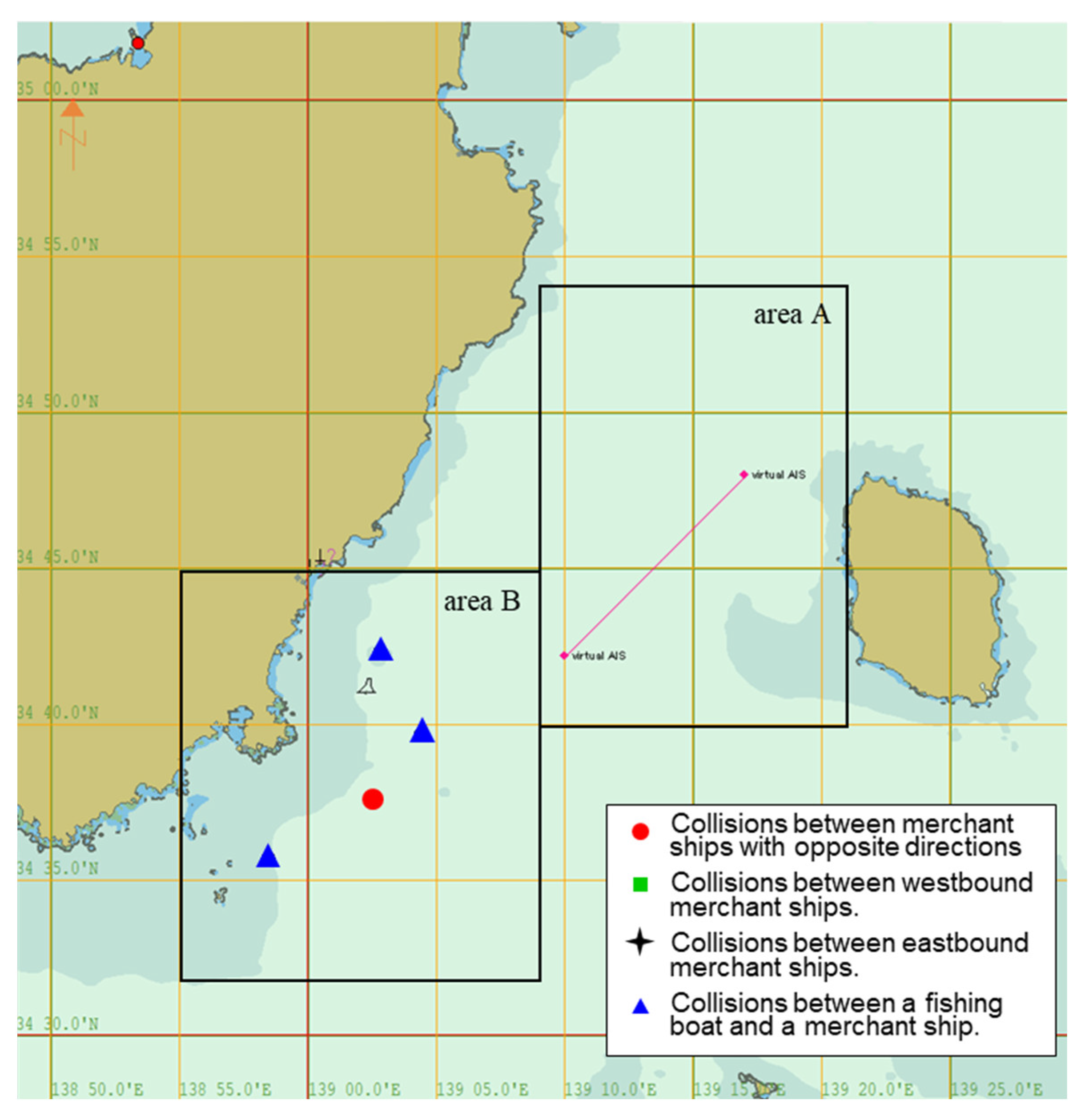
| Ship Type | Ship Size | Category ID | Number of Ships | Speed (kn) | Length (m) | Breadth (m) | |||||
|---|---|---|---|---|---|---|---|---|---|---|---|
| Gross Tonnage | Day | Night | Mean | SD | Mean | SD | Mean | SD | |||
| Tanker, cargo, and others | Large ships | 2 | 6.6 | 160.0 | 15.64 | 3.80 | 236 | 60 | 39 | 11 | |
| Medium ships | 1 | 10.9 | 11.5 | 13.56 | 2.87 | 112 | 12 | 17 | 2 | ||
| Small ships | 500 and above | 0 | 13.5 | 29.9 | 11.47 | 2.01 | 77 | 10 | 13 | 2 | |
| Less than 500 | 4 | 45.6 | 56.7 | 11.22 | 1.70 | 47 | 17 | 9 | 2 | ||
| Passenger | all | 3 | 0.2 | 2.6 | 17.37 | 3.65 | 49 | 46 | 10 | 6 | |
| Fishing boat | all | 5 | 163.0 | 20.0 | — | — | 13 | 1.20 | 2.1 | 0.45 | |
| Total | — | 239.7 | 136.9 | — | — | — | — | — | — | ||
| Collision by Encounter Type | Area A | Area B | ||
|---|---|---|---|---|
| Before 1,2 | After 1,2 | Before 1,2 | After 1,2 | |
| Between merchant ships with opposite directions | 6 (0.60) | 0 (0.00) | 3 (0.30) | 1 (0.24) |
| Between westbound merchant ships | 0 (0.00) | 0 (0.00) | 0 (0.00) | 0 (0.00) |
| Between eastbound merchant ships | 0 (0.00) | 0 (0.00) | 2 (0.20) | 0 (0.00) |
| Between a fishing boat and a merchant ship | 3 (0.30) | 0 (0.00) | 4 (0.40) | 3 (0.71) |
Publisher’s Note: MDPI stays neutral with regard to jurisdictional claims in published maps and institutional affiliations. |
© 2022 by the authors. Licensee MDPI, Basel, Switzerland. This article is an open access article distributed under the terms and conditions of the Creative Commons Attribution (CC BY) license (https://creativecommons.org/licenses/by/4.0/).
Share and Cite
Miyake, R.; Itoh, H. Design and Safety Assessment of Recommended Route off the Western Coast of Izu O Shima Island. J. Mar. Sci. Eng. 2022, 10, 1060. https://doi.org/10.3390/jmse10081060
Miyake R, Itoh H. Design and Safety Assessment of Recommended Route off the Western Coast of Izu O Shima Island. Journal of Marine Science and Engineering. 2022; 10(8):1060. https://doi.org/10.3390/jmse10081060
Chicago/Turabian StyleMiyake, Rina, and Hiroko Itoh. 2022. "Design and Safety Assessment of Recommended Route off the Western Coast of Izu O Shima Island" Journal of Marine Science and Engineering 10, no. 8: 1060. https://doi.org/10.3390/jmse10081060
APA StyleMiyake, R., & Itoh, H. (2022). Design and Safety Assessment of Recommended Route off the Western Coast of Izu O Shima Island. Journal of Marine Science and Engineering, 10(8), 1060. https://doi.org/10.3390/jmse10081060





